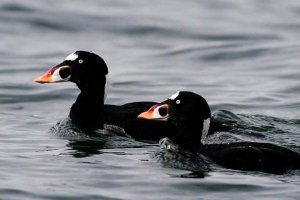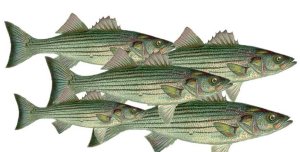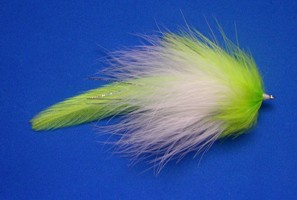 When migrating sea ducks begin to outnumber the terns, cormorants, and even the seagulls in Boston Harbor the
striper season is near its end. Add a big storm in early November and it is certainly over. Then, if you like,
you can drive south to where the water is still warm—Cape Cod or Rhode Island. Or you can put the rod away and
wait until next year. I caught my last striper in early November. I don't expect to catch another until May. It's too
cold, for me and for the fish.
When migrating sea ducks begin to outnumber the terns, cormorants, and even the seagulls in Boston Harbor the
striper season is near its end. Add a big storm in early November and it is certainly over. Then, if you like,
you can drive south to where the water is still warm—Cape Cod or Rhode Island. Or you can put the rod away and
wait until next year. I caught my last striper in early November. I don't expect to catch another until May. It's too
cold, for me and for the fish.
2007 was the best year for striped bass I've ever had. There were more of them and they were larger than in years past. Re-reading my fishing log for this year was a great pleasure. Beyond serving as a source of factual information, it brought back a lot of happy memories. Keeping a log or diary is something I recommend to everyone. I've been keeping a fishing diary since 1958 when I was just a kid starting my journey through life and taking the first tentative steps towards becoming a fly fisherman. Leafing through that faded notepad now, I can tell you that on Saturday, April 27, 1958, "I went fishing with Ed to Willowdale Dam, Ipswich River, but I didn't catch anything. Finally we went to Fish Brook and I caught a small brook trout on a wooly worm." Not a lot of detail but enough to recall a day almost fifty years in the past, the day I caught my first trout on a fly. The world has changed since 1958. Today I write my fishing notes on a computer rather than on paper. It's to these notes I now turn to recapture some of the flavor of the past season.
Late April
Striper fishermen are going to find big changes along much of the coastline this season. Winter storms and subsequent relentless (and sometimes "monster") wave action, have moved a lot of sand and rocks around, filling in some areas and scooping out others. Some favorite fishing areas will be improved; others have deteriorated or simply disappeared. So be prepared to "rediscover" many of your favorite wading spots. This is not a bad thing. On the contrary, it's one of the more interesting aspects of wade-fishing the New England coast; the constant change forces us to relearn the water every year and moves us away from falling into "habitual" fishing that requires little or no thought and into the realm of intelligent observation and thoughtful technique.
One important tip for the wader: Even if you think you know your water well, when you approach it for the first time this year, be sure to approach it at low tide (or on the falling tide through low tide), so that you're able to take note of any new holes or channels that you might fall into or that may keep you from wading safely back to shore.
Late May
Spring is here! Lilacs are in bloom, the days are getting longer (and sometimes warmer), the Red Sox are in first place, and the stripers are beginning to show up in good numbers. Truly a great time to be alive. I've been out fishing for stripers for a couple of weeks now (caught my first on May 7) and have had increasing success on each day since, finding more and more stripers arriving or becoming active with the warmer weather, slightly warmer water, and increasing numbers of bait fish.
May 29: I've just returned from a few hours of striper fishing in the Inner Harbor area and the fishing was truly excellent—with four fish over 26" and numerous smaller fish. Lots of action--and for the first time most of it on top with Gurglers. Yesterday was even better, with many smaller fish in the 20" - 25" range. Fish were everywhere throughout the harbor, it seemed, and also on the outside, from Winthrop over to Revere and Lynn. The amount of bait around right now is really impressive, mostly silversides. While the fish are still a little on the small side, I've caught two over 36" in the past week, both from shore while wading. A very good sign. I caught one on a #1/0 chartreuse/white Beastmaster fished just under the surface and the other on a Gurgler.
Late June
 Summer has arrived with its typical swings of temperature—a few days in the 50s, a few in
the 90s, and a few days in between. This past week has been consistently in the 90s, very sunny, with strong
southwest winds so I put off fishing for most of the week and concentrated instead on my tying and other tasks.
Summer has arrived with its typical swings of temperature—a few days in the 50s, a few in
the 90s, and a few days in between. This past week has been consistently in the 90s, very sunny, with strong
southwest winds so I put off fishing for most of the week and concentrated instead on my tying and other tasks.
The last time I went striper fishing, I found bait fish in the Inner Harbor and along the ocean front with lots of stripers hanging around them. This can be both good and bad. The good is that when bait fish first show up in numbers the stripers often go on a feeding frenzy and are relatively easy to catch. Once satisfied, however, they will often not feed regularly again until they are hungry.
Fortunately for us, hunger is not the only motivation for a striper to take a fly. Another is curiosity or instinctual aggressiveness. When fishing for "satisfied," hard-to-motivate fish I've had a lot of success arousing them by fishing a large fly very fast across the surface, sometimes hopping and skipping it and making it move this way and that at different angles. This kind of fishing requires more than ordinary effort but it's a technique well-worth developing for hard-to-catch fish.
Late August
In general, the fishing has been very consistent, with small bunker and silversides showing up and also lots of larger bass. As usual in the summer, the fishing has been better early in the morning and later in the afternoon after the sun has lowered a bit, or when the day is overcast. The water remained cool throughout July and August both inside and outside the harbor, but has begun to warm up the past few days. Strangely enough, I've also been getting some hickory shad in some areas, especially on the incoming tide.
The past few weeks and I've seen more evidence of bass schooling up and blitzing balls of bait. On Saturday, early in the morning, there was surface activity along the inside shore of Deer Island and over on the Airport flats. Good reports also from the area around Spectacle Island, Marina Bay, and Castle Island. This is good news for the boat fisherman but it often makes the fishing more difficult for wade fishermen since fish that would normally scrounge the shoreline are now often drawn away. If blitzing bass are not your interest, you'd do well to fish any mussel-bedded area or clam flat two hours before the low tide up to about three hours into the rise (depending on the area—and also on how tall you are).
Mid-September

BeastMaster
It's really beginning to feel like fall, with cooler days and nights and much cooler water temperatures. With this general cooling trend and fewer hours of daylight, there has been a great increase in migratory fish activity, with huge numbers of baby bunkers, silversides, and even the occasional herring and smelt, moving up and down the coast. And, naturally enough, there are stripers and blues in hot pursuit.
The best part of fishing in the fall, to my mind at least, is that the fish are now doing much of their feeding on the surface or not too far below. No longer do you have to dredge them up from the bottom with heavy lines and fast-sinking flies but can now regularly catch them on the surface or just below, which to me is the most satisfying and thrilling way to catch them.
If you have a boat you often don't have to look very far; the Airport Flats, Deer Island Flats, Quincy Bay, Spectacle Island, Long Island, Dorchester Bay, you name it and you're likely find fish. Along the outside north shore, from Winthrop to Marblehead there have been large schools of bass (and some blues) working schools of bait.
If you want to avoid the obvious "birds and blitzes" scene,look around for nervous water or darker patches of water that often signify schools of fish. The other day while I was wade fishing, I noticed that a side channel close to shore was simply black with stripers. They weren't busting bait but simply slowly moving along. I had great action on a Gurgler, catching over two dozen very fat fish (averaging between 23"34").
Since the end of August I've only used a few flies: a white #1/0 Gurgler tied either with a bucktail or a saddle-wing tail and a #1/0 white or blue/white BeastMaster General or BeastMaster. These have accounted for ninety percent of all the fish I've caught. At times a white Soft Hackle Streamer can also be a killer, especially when the fish are keying in on smaller bait fish and are more likely to take a smaller fly. As an experiment to see if the fish are showing a preference for one fly or another, you may want to attach a Soft Hackle Streamer to the bend of a Gurgler with a 6" length of leader. If fish are grabbing mouthfuls of bait rather than single specimens, you might want to try tying one Soft Hackle Streamer to the bend of another as a two-fly rig. If you do this, be sure to bend the barbs down on each hook because it's not uncommon to catch a fish on each fly.
Early October
Striper fishing right now is hotter than the Boston Red Sox! There are so many fish around that I've taken to cutting off the points of my hooks just behind the barb so that I don't have to land as many of them (my shoulder, back, and wrist can't take the long fights right now). Within the past four days alone I've hooked over 300 stripers, all on a saddle-wing (flat wing) Gurgler.
The real thrill in striper fishing for me at this time of year is not fighting or landing fish but simply finding and fooling them. I enjoy watching their reactions, watching them come up to the surface to smash the fly. Sometimes the smaller fish leap over the fly two and three times like a rainbow trout before they finally connect. Larger fish swirl or bulge once or twice beneath the fly before they finally decide to smash it when you give the fly just one more twitch.
But October being what it is, the fish move constantly and you often have to move around yourself to find them. Whenever you see large groups of terns, gulls or cormorants gathered the fish are nearby. They may not be feeding at the moment (stripers, like you and me, when fed to the full, simply stop feeding), but they will be somewhere in the area and with patience and skill can be taken.
Late October

Full moon fishing
Striper fishing right now is perhaps not quite so hot as the Sox (who just swept the Rockies to win the World Series) but you can get lots of hits if you're in the right place at the right time—and maybe even a few home runs. There are zillions of baby bunkers, silversides, and the occasional herring and smelt. While not so numerous as they were last week, there are still large schools of stripers and blues to be found.
I've been fishing mostly in the afternoon—from 3 pm-dark—which is when most of the action occurs, especially on a bright and sunny day. Friends who fish the other end of the day, first light to about 9am, tell me that the fishing has been generally good at that time also. If the day is overcast (rare this past month) the action can occur at any time. The bass are smaller this week than week before, with lots of 18"-22" fish.
This time of year I fish only a Gurgler (a saddle-tail flat wing Gurgler) so it may be that smaller, faster fish are more likely to be caught than if I fished a deeper-sinking fly. But size to me isn't all that important (I love 'em all) so I prefer to go for the absolutely intoxicating thrill of seeing a fish rise up from the depths to smash the fly or leap out of the water tail-to-the-sky and then drop down on the fly.
November
Went fishing for the last time on November 2. Dave Skok picked me up in his Jeep Cherokee about 1.30 pm, an hour into the rise. The day was sunny but cool, about 53, just a little warmer than the water temperature. Hoping to find a late school of blitzing fish or working birds, we drove along Winthrop Beach over to Revere Beach. Not a sign of fish anywhere. We headed back to Winthrop to a channel where a few days before I had caught a lot of fish. After blind-casting for almost an hour I caught only two and Dave caught one. They were all about 26", each one fat and very strong for their size. Dave suggested we try the inside shoreline of Deer Island, where it was easier to wade at this stage of the tide, and it was here that I caught my last striper of the season. Shortly after landing it the sky began to darken and the wind picked up. A big storm was predicted for later in the day and we decided to pack it in. We both knew that the season was just about over.






